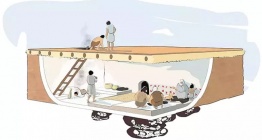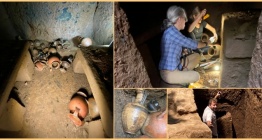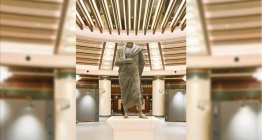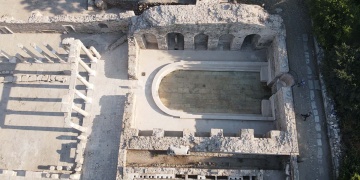The Mayan Train Project has received backlash from a variety of stakeholder groups, including environmentalists, archaeologists, and cave divers. Critics argue that the rapid pace of construction could jeopardize the integrity of these ancient sites and prevent meaningful archaeological work from being conducted in a timely manner.
According to news of The Pinnacle Gazette; concerns grow over the impact of a Mexican infrastructure project on prehistoric remains and environmental preservation...
In a striking intersection of archaeology and modern infrastructure, recent discoveries about ancient human remains have raised alarm bells regarding the potential impact of the Mexican government’s ambitious Maya Train project. The project, designed to loop around the Yucatán Peninsula, aims to boost tourism and connect various beach resorts and archaeological sites. However, serious concerns have emerged about how this highly publicized endeavor might threaten priceless cultural artifacts and the very caves that hold evidence of our human past.
In September 2022, a prehistoric human skeleton was discovered submerged in a flooded cave system near Tulum, along the Caribbean coast of Mexico. On September 10, archaeologist Octavio del Rio unearthed fragments of the skeleton while diving in the underwater cave. This find drew immediate attention, as it painted a complex picture of human history, migration, and ancient environments that could date back over 8,000 years.
As reports began circulating regarding new discoveries within these caves, the National Institute of Anthropology and History (INAH) of Mexico stepped in to clarify the situation. INAH announced that the skeleton was not a recent discovery but rather a find registered back in 2019 as part of their Holocene Archaeology program. They reassured the public that this ancient skeleton, approximately 400 yards from the planned route of the Maya Train, would not be directly threatened by the construction of the high-speed rail project.
"The referenced skeleton corresponds to a 2019 discovery and is fully registered and identified as part of the Holocene Archaeology program," the INAH stated. They emphasized that scientific analysis of the findings still needed to be performed, causing public intrigue about what further insights lie beneath the cave surface.
Del Rio, who has previously collaborated with INAH but is not presently affiliated with them, expressed his concerns about the long delays in studying the skeleton. He noted that the time it takes for archaeological investigations is often extensive, particularly in the intricate and expansive cave systems that lie within the Maya Train’s path. "This proves the area’s archaeological potential for investigation of the first settlers of America, and what there still is to discover," Del Rio emphasized, reinforcing the notion that these ancient remains hold substantial historical significance.
Del Rio described the skeleton as resting approximately eight meters underwater, deep within the cave system. Given its depth and location—far into the cave, around half a kilometer from the entrance—it could only have been accessed using modern diving gear. This leads to the conclusion that the remains had been there for thousands of years, likely since the time when sea levels rose and flooded the caves at the end of the last ice age.
This revelation connects with broader concerns over the Maya Train project and its potential effects on archaeological sites and the natural environment. Previous excavations nearby have uncovered some of the oldest human remains in North America, and the areas surrounding these cenotes have long been recognized as archaeologically rich.
However, the rush to construct the Maya Train has provoked backlash from a diverse group of stakeholders, including environmentalists, archaeologists, and cave divers. Critics argue that the rapid pace of construction could very well compromise the integrity of these ancient sites, preventing meaningful archaeological work from being conducted in a timely manner.
"The government’s insistence on moving forward with construction only serves to illustrate the profound conflicts between development and preservation," noted environmental advocate Ana Torres. Activists firmly believe that the high-speed rail project is bound to fragment the coastal jungle and interfere with the delicate limestone caves, which are often narrow, twisted, and filled with water—making exploration a daunting task. They worry that the mere vibration from construction activities could lead to the deterioration of existing cave systems and damage priceless archaeological findings.
Environmentalists have previously raised alarms that certain caves along the Yucatán Peninsula have already borne the brunt of construction efforts. Instances of damage from heavy machinery and cement structures designed to support roads and rail have been noted, which compromises both the sites themselves and the fragile ecosystem that surrounds them. Critics fear that the Maya Train could destroy key habitats and erode the environmental integrity of the region.
As President Andrés Manuel López Obrador's government moves forward with the Maya Train project, the sense of urgency has intensified. With just two years left in his term, the administration is eager to complete this project. However, many archaeologists and environmentalists argue that such a fast-tracked approach would leave inadequate time for conducting thorough archaeological surveys and reflections on the sedimentary past that these caves represent.
The Maya Train is envisioned to stretch around 950 miles (1,500 kilometers), running through the state of Quintana Roo and linking various tourist hotspots. Yet, the disruptions that may occur to both ecological and archaeological integrity evoke a pressing need for larger discussions around sustainable development and heritage protection in regions rich in historical and cultural assets.
Compounding these issues is the site's long history of harboring important archaeological finds. Other underwater caves and sinkholes have revealed clues about the migration and lifestyle of early inhabitants of the Americas, allowing researchers to piece together narratives regarding how these civilizations adapted to their environments.
In summary, as the construction continues to develop on the Maya Train, apprehension looms not only concerning the fate of the skeletal remains found in the cave but also regarding the future of numerous untouched archaeological sites that lie in the shadows of modern infrastructure. The tension between advancing tourism and conserving history could set the stage for a larger discourse on what it means to honor the voices of the past while pursuing the needs of the present—a challenge that the Mexican government must navigate with respect and care.
As this situation unfolds, many fear that the choices made today regarding the Maya Train project will leave lasting implications on cultural heritage and ecology in the Yucatán Peninsula, a region pivotal to understanding both ancient and contemporary human experiences.







 Müzeler kültür yuvası olmaktan çıkıp birer "Fotoğraf Durağı"na mı dönüşüyor?
Müzeler kültür yuvası olmaktan çıkıp birer "Fotoğraf Durağı"na mı dönüşüyor?  Bitlis'teki Selçuklu Kalesi'nde Yapılan Kazılarda Sikke ve Seramikler Bulundu
Bitlis'teki Selçuklu Kalesi'nde Yapılan Kazılarda Sikke ve Seramikler Bulundu  Çaltılar Höyük'teki Arkeolojik Kazılar Devam Ediyor
Çaltılar Höyük'teki Arkeolojik Kazılar Devam Ediyor  Stratonikeia Antik Kenti'ndeki Roma Hamamında Restorasyon Tamamlandı
Stratonikeia Antik Kenti'ndeki Roma Hamamında Restorasyon Tamamlandı 




